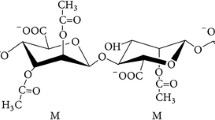Abstract
Candida guilliermondii FTI 20037 cells were entrapped in Ca-alginate beads and used for xylose-to-xylitol bioconversions during five successive batches in a stirred tank reactor. Supplemented sugarcane bagasse hemicellulosic hydrolysate was used as the fermentation medium. The average volume of the Ca-alginate beads was reduced by about 30% after the 600 h taken to perform the five bioconversion cycles, thus demonstrating physical instability under the conditions prevailing in the reactor vessel. In spite of this, almost steady bioconversion rates and yields were observed along the repeated batches. In average values, a production of 51.6 g l−1, a productivity of 0.43 g l−1 h−1 and a yield of 0.71 g g−1 were attained in each batch, variation coefficients being smaller than 10%.



Similar content being viewed by others
Abbreviations
- D :
-
diameter of the Ca-alginate beads (mm)
- P :
-
xylitol concentration (g l−1)
- Q P :
-
xylitol productivity [Q P = P/t] (g l−1)
- S :
-
xylose concentration (g l−1)
- t :
-
fermentation time (h)
- V :
-
volume of individual Ca-alginate beads (mm3)
- V I :
-
volume of Ca-alginate beads in the reactor (l)
- V M :
-
volume of fermentation medium in the reactor (l)
- V R :
-
volume of reactor [V R = V I + V M ] (l)
- X I :
-
concentration of immobilized cells in the Ca-alginate beads (g l−1)
- X M :
-
concentration of free cells in the fermentation medium (g l−1)
- X R :
-
concentration of cells in the reactor (g l−1)
- X RI :
-
concentration of immobilized cells in the reactor (g l−1)
- X RI% :
-
percentage of immobilized cells in the reactor (%)
- X RM :
-
concentration of free cells in the reactor (g l−1)
- Y P/S :
-
xylose to xylitol bioconversion yield [Y P/S = ΔP/ − ΔS] (g g−1)
- μ P :
-
specific rate of xylitol production (g g−1 h−1)
- μ S :
-
specific rate of xylose consumption (g g−1 h−1)
- μ XR :
-
specific rate of cell growth (h−1)
- μ XRI :
-
specific rate of immobilized cell growth (h−1)
- μ XRM :
-
specific rate of free cell growth (h−1)
References
Bar A (1986) Xylitol. In: O’Breen Nabors L, Gelardi R (eds) Alternative sweeteners. Marcel Dekker, New York, pp 185–216
Pepper T, Olinger PM (1988) Xylitol in sugar-free confections. Food Technol 42:98–106
Mattila PT, Svanberg MJ, Jamsa T, Knuuttila MLE (2002) Improved bone biomechanical properties in xylitol-fed aged rats. Metab Clin Exp 51:92–96
Emodi A (1978) Xylitol: its properties and food applications. Food Technol 12:28–32
Uhari M, Tapiainen T, Kontiokari T (2000) Xylitol in preventing acute otitis media. Vaccine 19:144–147
Carvalho W, Silva SS, Vitolo M, Felipe MGA, Mancilha IM (2002) Improvement in xylitol production from sugarcane bagasse hydrolysate achieved by the use of a repeated-batch immobilized cell system. Z Naturforsch C 57:109–112
Carvalho W, Silva SS, Santos JC, Converti A (2003) Xylitol production by Ca-alginate entrapped cells: comparison of different fermentation systems. Enzyme Microb Technol 32:553–559
Le Duy A, Zajic JE (1973) A geometrical approach for differentiation of an experimental function at a point applied to growth and product formation. Biotechnol Bioeng 15:805–815
Quirós C, Rendueles M, Garcia LA, Diaz M (1995) Diffusion of microorganisms in calcium alginate beads. Biotechnol Tech 9:809–814
Pilkington PH, Margaritis A, Mensour NA (1998) Mass transfer characteristics of immobilized cells used in fermentation processes. Crit Rev Biotechnol 18:237–255
Chen KC, Huang CT (1988) Effects of the growth of T. cutaneum in calcium alginate gel beads upon bead structure and oxygen transfer characteristics. Enzyme Microb Technol 10:284–92
Santos VAPM, Leenen EJTM, Rippoll MM, Sluis C, Vliet T, Tramper J, Wijffels RH (1997) Relevance of rheological properties of gel beads for their mechanical stability in bioreactors. Biotechnol Bioeng 56:517–529
Sene L, Felipe MGA, Vitolo M, Silva SS, Mancilha IM (1998) Adaptation, reutilization of Candida guilliermondii cells for xylitol production in bagasse hydrolysate. J Basic Microbiol 38:61–69
Carvalho W, Santos JC, Canilha L, Almeidae Silva JB, Felipe MGA, Mancilha IM, Silva SS (2004) A study on xylitol production from sugarcane bagasse hemicellulosic hydrolysate by Ca-alginate entrapped cells in a stirred tank reactor. Process Biochem 39:2135–2141
Carvalho W, Canilha L, Silva SS (2007) Semi-continuous xylitol bioproduction in sugarcane bagasse hydrolysate: effect of nutritional supplementation. Br J Pharm Sci 43:47–53
Silva SS, Ribeiro JD, Felipe MGA, Vitolo M (1997) Maximizing the xylitol production from sugarcane bagasse hydrolysate by controlling the aeration rate. Appl Biochem Biotechnol 63, 64:557–563
Canilha L, Carvalho W, Almeida e Silva JB (2006) Xylitol bioproduction from wheat straw: hemicellulose hydrolysis and hydrolysate fermentation. J Sci Food Agric 86:1371–1376
Silva CJM, Mussatto SI, Roberto IC (2006) Study of xylitol production by Candida guilliermondii on a bench bioreactor. J Food Eng 75:115–119
Sampaio FC, Mantovani HC, Passos FJV, Moraes CA, Converti A, Passos FML (2005) Bioconversion of D-xylose to xylitol by Debaryomyces hansenii UFV-170: product formation versus growth. Process Biochem 40:3600–3606
Groboillot A, Boadi DK, Poncelet D, Neufeld RJ (1994) Immobilization of cells for application in the food industry. Crit Rev Biotechnol 14:75–107
Acknowledgments
The authors gratefully acknowledge the financial support of Fapesp and CNPq.
Author information
Authors and Affiliations
Corresponding author
Rights and permissions
About this article
Cite this article
Carvalho, W., Canilha, L. & Silva, S.S. Semi-continuous xylose-to-xylitol bioconversion by Ca-alginate entrapped yeast cells in a stirred tank reactor. Bioprocess Biosyst Eng 31, 493–498 (2008). https://doi.org/10.1007/s00449-007-0187-z
Received:
Accepted:
Published:
Issue Date:
DOI: https://doi.org/10.1007/s00449-007-0187-z




